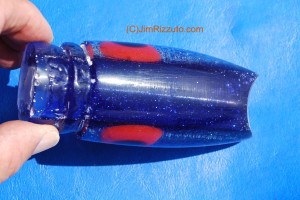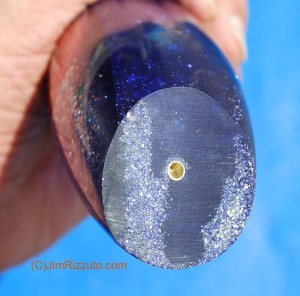The Lure-Making Tips blog is for readers who already know the techniques and methods explained in the books Lure-Making 101/102 and Lure-Making 201/202. If you don’t have these books, be sure to get them.
The two lures in the photo are being compared for size, only. The upper lure is a “Fat Boy” dating back to 1963. The bottom lure is a Joe Yee Superplunger, first produced in the early 1980s. The Fat Boy weighs 10 ounces and
 the Superplunger 8 ounces. Notice that next to the Fat Boy, the Superplunger doesn’t look quite so super. We are focusing on the Fat Boy to provide some special perspective for newcomers to the skills of making and trolling Hawaii-style big-game lures. That means you, if you weren’t around here in the 1960s when lure-making went wild and every one with a boat and a fishing rod was designing and making new styles every week.
the Superplunger 8 ounces. Notice that next to the Fat Boy, the Superplunger doesn’t look quite so super. We are focusing on the Fat Boy to provide some special perspective for newcomers to the skills of making and trolling Hawaii-style big-game lures. That means you, if you weren’t around here in the 1960s when lure-making went wild and every one with a boat and a fishing rod was designing and making new styles every week.
In size, shape, and weight, the Fat Boy copies a lure that Zander Budge made in 1963 and used to catch the men’s 80-pound class Pacific blue marlin record soon after. It was one of the first blue marlin records from Hawaii and only the second or third record anywhere on a Hawaii-style trolling lure.
I borrowed Zander’s “Fat Boy” mold and was soon turning these out for my own use and to illustrate articles about lure-trolling for newspapers, books and magazines. (No internet back then, of course, which is one reason I’m doing this now.) The flashy purple one pictured is a model I turned out a few months ago.
From the side, the Fat Boy looks very much like many of the lures on the market today. Much of today’s arguments about who is copying whom begin to look ridiculous when you consider that most “new” shapes go back before all but the oldest lure makers were born.
Like many of the lures from the 1960s and into the 1970s, the Fat Boy has a scooped face, which gave it a wild  action. Flat-face, center-pull lures were among the first marlin lures back in the 1940s and 1950s and continued to evolve today into the most common lures in use on modern boats. The flat face lures (like the Superplunger shown) plow straight ahead with a steady action that minimizes tangles with other lures in the spread.
action. Flat-face, center-pull lures were among the first marlin lures back in the 1940s and 1950s and continued to evolve today into the most common lures in use on modern boats. The flat face lures (like the Superplunger shown) plow straight ahead with a steady action that minimizes tangles with other lures in the spread.
The scoop is hard to shape unless you know the trick and have the tool. This scoop was cut on a table-mounted belt sander and makes use of the curved end of the moving belt.
Unlike most of the scooped face lures of the early days, the Fat  Boy has a leader tube positioned close to the center of the scoop. In this position, the leader tends to slow down the most eccentric gyrations but still gives the lure the inviting action for which these lures were famous.
Boy has a leader tube positioned close to the center of the scoop. In this position, the leader tends to slow down the most eccentric gyrations but still gives the lure the inviting action for which these lures were famous.
In this image of the scoop, the face still shows the score markings from the belt sander. Those marks give you some sense of how the scoop was made.
Unlike today’s lure crafters, back then many of us left the front face unpolished. We were always tinkering with the lure face to “improve” the action and polishing seemed to be a waste of time. In fact, we convinced ourselves that the unpolished surface was better because it helped the lure bite the water and churn up more bubbles. Mostly, we were just too lazy to polish the faces.
ron freitas
great web site Jim , thank you for sending it to me Ron
Sean
Thanks for sharing your knowledge